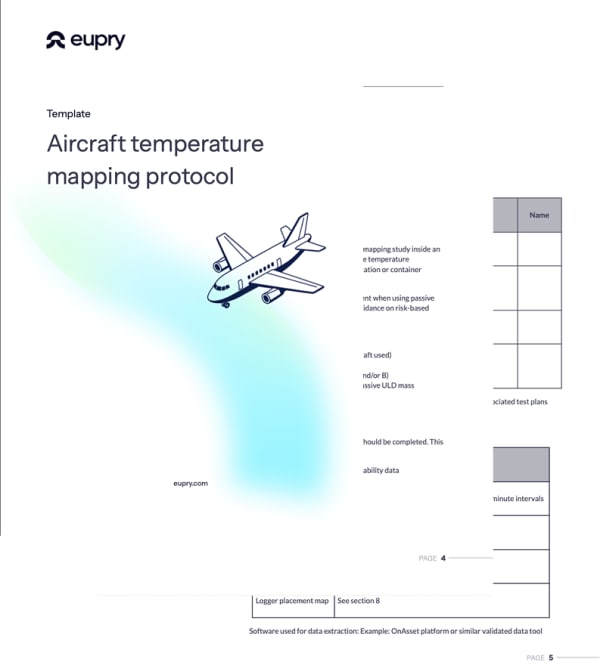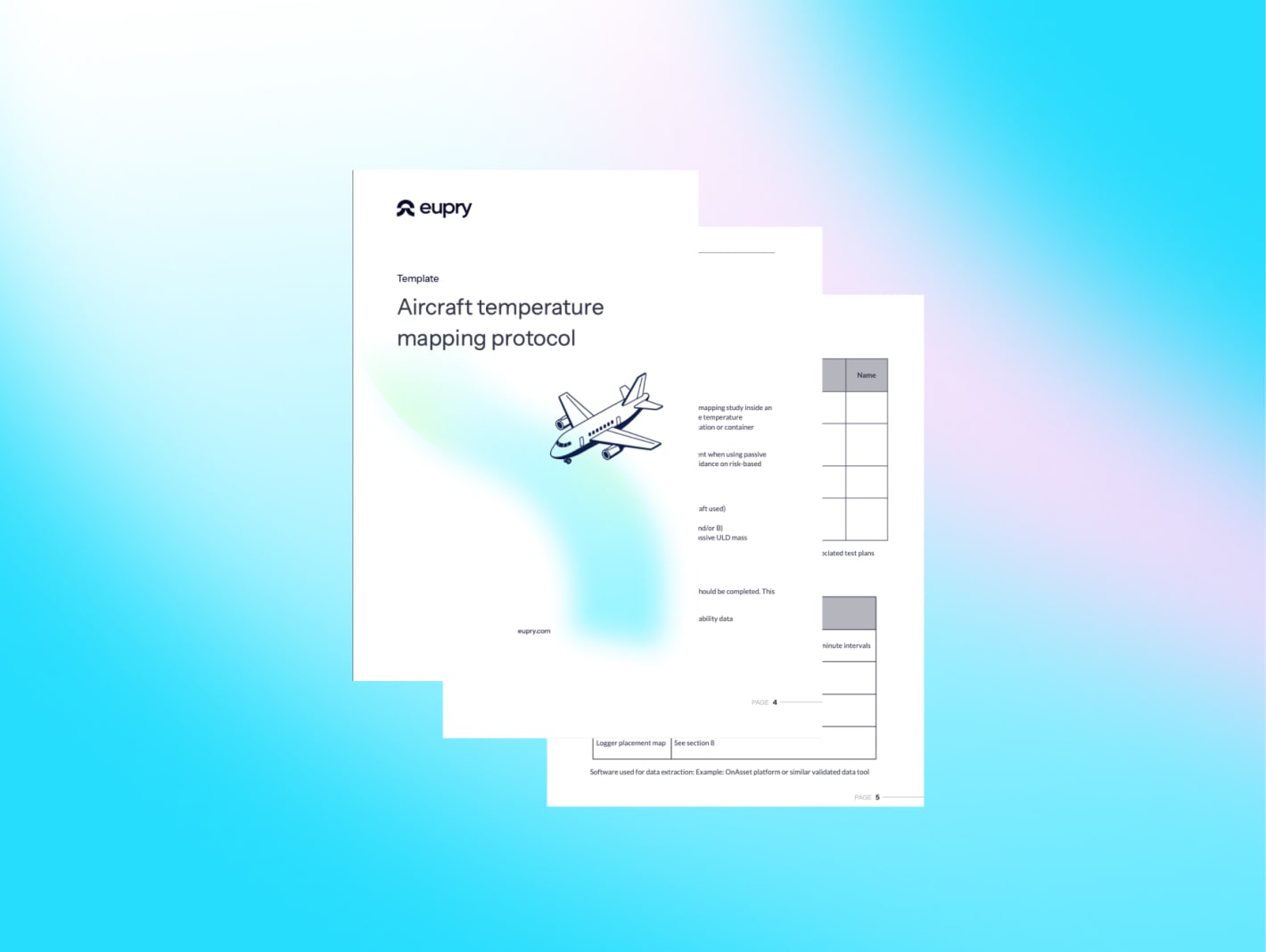Aircraft temperature mapping

Adam Hartmann-Kruckow
What is it all about - and why do it?
Pharmaceutical air freight is high risk – and the aircraft itself is often a blind spot. Learn how temperature mapping can unlock smarter ULD use and lane qualification.
Author: Adam Hartmann-Kruckow, Co-founder of Eupry
Get a detailed template to help you plan, execute, and document aircraft temperature mapping - aligned with GxP and GDP expectations.

Executive summary
Aircraft temperature mapping is a niche but emerging validation approach in pharmaceutical logistics. Although not required by GDP, CEIV, or GxP guidelines, it is gaining relevance as pharma companies seek to reduce freight costs and emissions by shifting from active to passive Unit Load Devices (ULDs).
This guide introduces the concept, clarifies when and why mapping is used, and explains how it supports lane qualification and proactive compliance strategies. It outlines the key steps to conduct a compliant mapping study – from test planning to final reporting – and highlights how aircraft mapping differs from traditional temperature mapping in storage or ground transport.
A free protocol template is included to help validation and QA teams plan and execute mapping studies in line with WHO, GDP, and GxP expectations.
Introduction to aircraft temperature mapping
Aircraft mapping is not a regulatory requirement, and it is not widely adopted in pharma logistics today. But it is gaining attention for a specific reason: It enables companies to make the switch from active to passive ULDs. That switch can dramatically reduce freight weight, emissions, and cost, but only if the aircraft environment is proven to be suitable.
This guide explores what aircraft mapping is, why some companies are doing it anyway, and how it can support your strategy, even if it is not required.
Also read: Guidelines for temperature of pharmaceutical air freight
What is aircraft temperature mapping in pharma logistics?
Aircraft temperature mapping involves placing calibrated data loggers in strategic positions across the main and lower cargo decks of an aircraft to monitor temperature behavior during real flight operations. The purpose is to document the thermal environment and identify any risks to temperature-sensitive products during air transport.
Also read: Temperature mapping: Tips, frameworks, and pitfalls
Is aircraft temperature mapping required by GDP or CEIV Pharma?
No: aircraft mapping is not currently required under GDP, CEIV Pharma, or other GxP frameworks. It is almost completely unknown and rarely done. Companies that use active unit load devices or ULDs or temperature-controlled containers typically do not need to map the aircraft at all.
As the industry seeks to cut costs and emissions, interest in passive ULDs — which are lighter and less expensive to ship — is growing. Aircraft mapping supports this shift by validating that cargo holds maintain stable temperatures without active cooling.
Why would you do aircraft temperature mapping if it is not required?
Even though it is not a regulatory requirement, aircraft temperature mapping is being adopted by pharma companies for practical, strategic reasons.
- Reduce reliance on expensive active containers by validating routes for passive [ULDs](/temperature-mapping/unit-load-devices-ulds]
- Document lane qualification with real data: supporting risk-based decisions
- Identify suitable compartments (e.g., lower hold) that are unexpectedly stable
- Demonstrate proactive quality assurance in audits and QMS documentation
- Strengthen internal decision-making by replacing assumptions with measured data
Aircraft mapping helps teams build internal confidence and regulatory defensibility when introducing lower-cost, lower-footprint transport options. It supports a shift toward more sustainable air freight without compromising quality.
Which guidelines and regulations apply to aircraft mapping?
While aircraft mapping is not a specific regulatory requirement, it aligns with several established frameworks and principles commonly used in pharmaceutical logistics and validation.
- WHO TRS 961 Annex 9: Recommends continuous monitoring and documentation of temperature-sensitive pharmaceutical product transport. While it does not mandate aircraft mapping, its emphasis on risk-based control supports it. Learn more about WHO’s mapping guidelines
- ISPE Good Practice Guide – Controlled Temperature Mapping: Outlines best practices for mapping controlled environments, which can be adapted to aircraft if conditions are documented and justified.
- GDP and GxP principles: Emphasize control, traceability, and validation of environments affecting product quality. Mapping supports these principles by generating real-world data for lane qualification.
- CEIV Pharma by IATA: Requires evidence of temperature control but does not prescribe aircraft mapping. However, mapping data can support CEIV audits and lane approvals.
Also read: How to achieve your CEIV pharmaceutical compliance certification
In essence, aircraft mapping is a proactive validation step in the world of healthcare logistics. It is not mandated, but it can demonstrate compliance when using passive containers, making the operations both more cost-efficient and sustainable.

Download an aircraft mapping protocol template
Get a step-by-step protocol to help you plan and execute aircraft temperature mapping in alignment with GDP, GxP, and WHO Annex 9. Ideal for validation teams qualifying air lanes or switching ULD strategies.
How is aircraft mapping different from other GxP temperature mapping?
Aircraft environments are dynamic and less controlled than warehouses, freezers, or trucks. Traditional temperature mapping focuses on stable, accessible spaces. Aircraft mapping breaks that pattern, requiring new approaches due to limited access and fluctuating thermal conditions.
Some of the factors that make aircraft mapping unique are:
- Access to the aircraft is limited to narrow windows, typically under 90 minutes, and must be coordinated with ground crews and flight operations
- ECS (Environmental Control Systems) are not evenly distributed. Upper decks are actively ventilated, while lower decks may rely on floor-embedded cooling lines or passive airflow
- Altitude, external temperature, and flight phase transitions (e.g., takeoff and descent) all affect thermal stability
- Real-time data must capture the full operational profile: loading, departure, cruising, descent, and unloading
In addition, aircraft mapping often requires working within FAA or airport safety restrictions, using validated loggers approved for in-flight use, and coordinating with airline partners, making the process more logistically complex than traditional storage validation.
Tip! Download an aircraft mapping protocol template here.
At the same time, aircraft mapping shares key similarities with other mapping practices:
- It follows a documented protocol, including predefined logger placement, calibration, and reporting
- It relies on traceable, calibrated measurement equipment
- It is performed to validate temperature uniformity and identify hot or cold zones
- It supports audit readiness and risk-based decision-making in line with GxP principles.
These commonalities mean that teams experienced in warehouse or transport validation can typically adapt to aircraft mapping with the right guidance and planning.
Also read: [Guidelines for risk-based temperature mapping in GxP]
What are the steps for conducting a pharmaceutical aircraft mapping?
A proper aircraft mapping study should follow a structured, documented process that aligns with GxP validation principles. Here is what a compliant process typically involves:
-
Define scope and test plan: Identify the aircraft model, define the target temperature range based on the product profile, and select specific cargo areas to evaluate. The test plan should also account for equipment, time windows, and route details.
-
Train personnel and prepare documentation: All personnel involved in logger handling, placement, and retrieval must be trained according to TP1. Training should cover SOPs, safety protocols, and data integrity practices.
-
Calibrate and label loggers: Loggers must be traceably calibrated and labeled for identification and auditability. Each logger ID should be tied to a placement zone and included in the final report.
-
Place loggers strategically: Sensors should be placed in multiple height tiers (top, middle, bottom) across both upper and lower decks, including near doors and heat-sensitive areas. This ensures thermal variation is captured accurately.
-
Conduct operational flight study: Perform the mapping during an actual flight under real cargo and route conditions. Loggers should record data continuously from pre-loading to unloading — including taxi, takeoff, cruising, and descent.
-
Extract and analyze data: Evaluate raw data for temperature stability, calculate Mean Kinetic Temperature (MKT), and identify any outliers or excursions. Data should be reviewed using approved software tools.
-
Compile and review final report: Create a validation report including min/max temperatures, placement maps, time-series graphs, and root cause analysis for deviations. The report must be reviewed and approved by QA before use in decision-making.
Also see: Guidelines for temperature of pharmaceutical air freight
Download a free aircraft mapping protocol
Plan, execute, and document aircraft mapping in pharma aligned with GDP, CEIV, and WHO guidance using this protocol template.

FAQ about aircraft temperature mapping
Aircraft temperature mapping solutions for pharma
Need help planning your aircraft validation? Or any other GxP-regulated environment - from warehouse to ULTs and incubators?